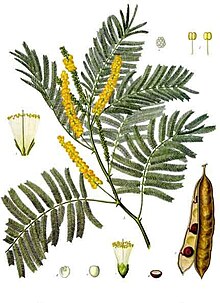Acacieae
| Acacieae | |
|---|---|
 |
|
| Senegalia catechu | |
| Scientific classification | |
| Kingdom: | Plantae |
| Clade: | Angiosperms |
| Clade: | Eudicots |
| Clade: | Rosids |
| Order: | Fabales |
| Family: | Fabaceae |
| Subfamily: | Mimosoideae |
| Tribe: |
Acacieae Dumort., 1829 |
| 5 or 6 genera | |
|
|
Acacieae is a wide-ranging, polyphyletic tribe of legumes in the Mimosoideae, that is native to the tropics, subtropics and warm-temperate regions. It includes five or six genera and some 1,450 species.
In Bentham's 1842 circumscription of the subfamily Mimosoideae, Acacieae was one of its three constituent tribes, the others being Ingeae Benth. & Hook.f. and Mimoseae Bornn. His Acacieae tribe of 1842 included many genera that were subsequently assigned to tribe Ingeae Benth. In 1875 however, Bentham narrowed his definition of Acacieae so as to include only Acacia Mill.
The only morphological character of Acacieae used to distinguish it from the Ingeae, is the presence of free stamens (as in tribe Mimoseae). In the Ingeae they are fused in the form of a tube, whereas in the Acacieae only a few species have the stamens fused at the base. Several characters of the foliage, seeds, seed pods, pollen and stipules are shared by the two tribes. The flower morphology of Acacia s.l. has characteristics in common with the genera Leucaena, Piptadenia and Mimosa (tribe Mimoseae) and Enterolobium and Lysiloma (tribe Ingeae).
The tribal position of monotypic genus Faidherbia A. Chevalier is equivocal. It was included in the Acacieae by Vassal (1981) and Maslin et al. (2003), but Lewis & Rico Arce placed it in tribe Ingeae following Polhill (1994) and Luckow et al. (2003). In the latter case tribe Acacieae may conform to genus Acacia s.l., pending the latter's relationship to other mimosoid genera. Faidherbia is troublesome as its stamens are shortly united at their base and its pollen is similar to some taxa in the Ingeae.
They are trees, shrubs or lianas, which may be armed or unarmed. Where they have spines, these are modified stipules. In some, prickles arise from the stem's cortex and epidermis. The leaves are bipinnate or are modified to vertically oriented phyllodes. A few have cladodes rather than leaves.Extrafloral nectaries may be present on the petiole and rachis, and the pinnule tips may carry protein-lipid Beltian bodies. The leaflets are usually opposite, and are carried on shortly stalks or are sessile. The heartwood is typically red and hard, and the sap of various species hardens into gum.
...
Wikipedia
